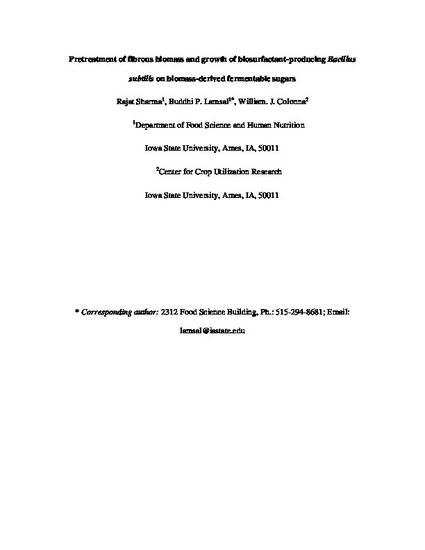
Pretreatment of six fibrous biomasses (switchgrass, alfalfa, soy hulls, soy fiber, DDGS and Baggase) and subsequent hydrolysis using cellulolytic enzymes at a 2.5% (v/v) and 5% (v/v) loading 2.5 (v/v) and 5% (v/v) loading was compared for higher amounts of sugars released. Soaking of biomasses of switchgrass, alfalfa, soy hulls and bagasse in 15% w/w ammonia was optimal at 60 °C for 12 h, followed by enzymatic hydrolysis, yielding 72, 70, 80 and 75% carbohydrate conversions, respectively. However, soaking in ammonia was not needed for soy fiber and DDGS as these contained very little lignin. Ultrasonication for 3 min @ 100% amplitude (170 µM) was found to be optimal for soy fiber and DDGS from which 77 and 83% carbohydrate conversion, respectively, was obtained following enzyme treatment at 5% (w/v) enzyme. The sugars released by enzymatic hydrolysis of pretreated biomass were utilized as an energy source by Bacillus subtilis in fermentation media at 2% (w/v) of concentration. In shake flask trials, cell growth was 15-20% higher on hydrolysates of ammonia-treated switchgrass and alfalfa vs. glucose-based control media due to the presence of a wider range of monomeric sugars (glucose, xylose, arabinose, mannose and galactose). In contrast, growth was less on soy hull hydrolysates prepared with ammonia pretreatment.
Available at: http://works.bepress.com/buddhi_lamsal/24/

This accepted article is published as Sharma, R., Lamsal, B. P.*, Colonna, W.J. 2016. Pretreatment of fibrous biomass and growth of biosurfactant-producing Bacillus subtilis on biomass-derived fermentable sugars, Bioprocess and Biosystems Engineering, 39(1): 105-113. DOI: 10.1007/s00449-015-1494-4. Posted with permission.